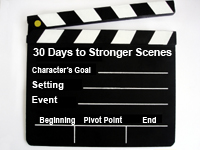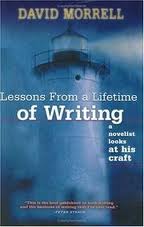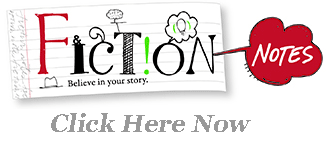 Join us on Facebook for a discussion of scenes.
Join us on Facebook for a discussion of scenes.

Best Length for Scenes?
What’s the best length for a scene? IS there a best length?  In his book, Lessons from a Lifetime of Writing, action/adventure author, David Morrell (creator of the Rambo character, among others), says he tries to write short chapters (or we can translate this to scenes, too), so that a reader can complete one chapter (or structural unit, i.e. a scene) at one sitting.
In his book, Lessons from a Lifetime of Writing, action/adventure author, David Morrell (creator of the Rambo character, among others), says he tries to write short chapters (or we can translate this to scenes, too), so that a reader can complete one chapter (or structural unit, i.e. a scene) at one sitting.
He bases his ideas on two essays by Edgar Allen Poe, The Philosophy of Composition and The Poetic Principle. Poe argues that short scenes/chapters are better because they accommodate the human form which needs to move around. We get up to go to the bathroom, to relieve a hurting back, etc. By keeping scenes short, you will keep the reader turning pages and actually reading every word.
Morrell says he keeps his structural units small in order to accommodate the reader’s bladder, TV interruptions, phone calls, a neighbor who drops in, etc. Poe’s essay is worth reading, as is Morrell’s chapter on “The Tactics of Structure.”
So, there’s not really a right or wrong. I’ve read 30 page scenes and I’ve read 1/3 page scenes. Whatever works. But if in doubt, short is better than longer. (Kinda reminds me of blog posts! Short is often better.)

When Stories Start to Go Wrong!
Here are some descriptions of manuscripts. Read them and figure out what’s wrong:
- 6000 word, ABC book
- 13,000 word middle grade
- 250,000 YA/teen novel
- 2000 word YA poetry book
- 4000 word picture book
Match Audience with Length and Format of Your Story
In each of these cases, the format, especially the length of the manuscript, does not match up with the intended audience.

Here’s a typical run down of manuscript lengths for different formats:
Picture book, including ABC titles. The hottest items are under 500 words. Some picture books can go up to 2000 words, but those are iffy. The audience for picture books can be anything from birth to about 10 years old. Usually the break down is something like 1-3 years old, 2-4, 4-8 or 6-10, though it varies from publisher to publisher.
The best advice for a picture book manuscript is “cut it in half.” Yes, it’s hard in 500 words to have a beginning, middle, end, a satisfying narrative arc, and a character that kids want to spend time with. Welcome to the difficult world of picture books.
ABC books, especially Sleeping Bear Press ABC titles, sometimes will go longer. But essentially the ABC format is just a way to organize information. These are not true ABC books for preschoolers.
Beginning reader and early chapter books. These are aimed at the beginning reader, so ages 4-8. For the truly beginning reader, the text may just be a couple words on each page. This is the only place where a publisher will try to control vocabulary, choosing words with regular spelling or from the sight vocabulary lists. By second grade, though, kids are reading short chapter books, and there’s more leeway in vocabulary and complexity of texts. These run maybe 6000-12,000 words, again depending on a publisher’s inclination and publishing program. Usually these are contemporary stories, grounded in a child’s real world.
Short chapter books. Some people add this category for 3-4th graders. These are short novels (novelettes?) of about 12,000-20,000 words. The topic of these books changes slightly to allow for historical fiction, science fiction or fantasy, or mysteries.
Middle grade novels. For grades 5-8, or about 10-14 years old, the middle grade audience has a wide variety of interests that are reflected in their fiction. Novels for this group run 30-80,000 words, but tend to fall more in the 40-60,000 range. Only the rare Harry Potter will go to 100,000 or more.
YA/Teen novels. For ages 12 and up, the YA or Teen novel has an almost free rein in length, complexity and subject matter. Still even here, the average novel might run 60,000 or so. You can go longer or shorter, if there’s a good reason for it. Some have said that YA novels are just like adult novels, just 100 pages shorter and without the sex scene. Today, you can add both the 100 pages and the sex scene. What distinguishes this literature is the tone of the story, particular the tone of rebellion of some sort. It’s a time of life when kids must break with their parents and figure out life for themselves; that’s what is reflected in the liter
Stop! Before you send out that picture book manuscript, cut it by at least one-third. Really. Make that revision.
Biggest Mistake in Picture Book Manuscripts
I recently read a picture book manuscript from a novice writer and it had the usual problem: too long.
 In a picture book manuscript, every word counts, so you must test each and every word to see if it belongs there. Here are four places to cut:
In a picture book manuscript, every word counts, so you must test each and every word to see if it belongs there. Here are four places to cut:
- Repetitive words. Never, never repeat a word unless you absolutely must, or unless it adds to the story. Sure, when you write a first draft, you often repeat something by accident. But you should go through a picture book manuscript with a fine-toothed comb to make sure you’ve cut out any extras.
- Adjectives, Adverbs. Picture books need action; leave adjectives to the illustrator. Because it includes illustrations, you should only include the adjectives that make a difference. Grass is green. Duh. Only use adjective if, for example, your grass is purple.
For adverbs, please replace them with a stronger verb.
- The boy walked slowly.
- The boy limped.
- Clauses, Prepositional Phrases. Leave out the extra commentary (unless it’s part of the mss’ voice).
- Well, in the end, it was a day that pleased me greatly.
- I enjoyed the day.
Try rephrasing prepositional phrases by moving a word to an adjective position:
- It was a day of joy.
- It was a joyful day.
- Dialogue. Dialogue is unlike real speech; it’s compressed speech. Leave out the pleasantries and get to the heart of the conversation.
-
Hello.
Hello.
Why are you so late? I was waiting and waiting, just sitting on this bench, waiting for you. Why are you so late?
Well, I had a flat tire and I couldn’t get the lug nuts loose. So I had to wait until a policeman stopped. He was really nice, a big tall policeman and he was strong enough to loosen the bolts and finally I got the tire changed.
Oh.
Yes, well, I’m sorry I was so late.
-
Hey, what’s up? Why so late?
Sorry. I had a flat and couldn’t change it by myself. A cop stopped and helped and now, I’m here.
STOP! Cut Your Mss by 1/3. At Least!
Before you send out your mss, try to cut it by 1/3 without changing the story. Then try to cut another 50-100 words. Compare the before and after. If the story has changed (for the worse), you can add back a few words; but I’ll wager that the story will be much stronger with the revision.
While there are no hard and fast rules, picture books that run 500 words or less tend to sell better. For pre-school stories it’s a stricter limit than for school age (K-3).
Need more on how to write a children’s picture book? See our eBook, How to Write a Picture Book. Immediate download. $10.

By: Darcy Pattison,
on 2/16/2009
Blog: Darcy Pattison's Revision Notes
( Login to Add to MyJacketFlap)
JacketFlap tags:
children, Picture book, fiction, novel, writing, revision, create, manuscript, Darcy Pattison, write, length, Add a tag
How Firm are Book Publisher’s Guidelines on Book Length?
I had a question come up last week: how hard and fast are the rules about the length of a picture book manuscript? Can you get by with 1900 words? 2000 words? 2500 words?
The length requirements for every genre, from picture books to easy readers to short chapter to middle grade and teen novels — the recommended lengths are only guidelines.
Write your story the best way you can. Most editors will say to write the story you need to write. They will worry about how to fit it all into 32 pages, or if it should go to 48 pages or if it should be cut.
Some genres, some publishers are very strict on guidelines. On the other hand, some publishers and some genres have very strict guidelines. Easy readers are only allowed a certain number of characters per line and rarely exceed posted story length. If in doubt, ask the editor; or, simply follow the guidelines.
Consider your audience. You should also consider your readers and the characteristics and interests of the readers. For pre-school kids, do you really expect them to sit still and stay interested in something that is 2000 words long? Time yourself reading those 2000 words and consider the attention span of young children. Given a choice, wouldn’t they rather hear a story — complete with a beginning, middle, end and an emotional tug — in just 200 words?
Make sure you are matching up a story with an audience. If you are breaking the guidelines, ask yourself the tough question: is this story targeted to the right age audience?
Don’t fall in love with your words. Also, be sure — how to put this delicately — make sure you aren’t being lazy or sloppy in your writing. I’ve seen 2000 words stories that can easily be cut to 800 words and be all the better for it. I’ve had stories like that myself. Change as many verbs as possible to active verbs, eliminate all adverbs, and most adjectives; convert prepositional phrases to adjectives or omit; cut any redundancies; cut dialogue to bare minimum; etc. Cut.
Follow the guidelines — usually. In other words, the guidelines are guidelines for good reasons and if you ignore them, it is at your own peril. Yes, of course, you’ll find picture books at 1900 words; but they will be written for the upper elementary students, not the toddlers. But there will also be rare exceptions when the subject matter, the writing, or the genre will allow you to bend the guidelines — a little.

|
 Join us on Facebook for a discussion of scenes.
Join us on Facebook for a discussion of scenes.  In his book, Lessons from a Lifetime of Writing, action/adventure author, David Morrell (creator of the Rambo character, among others), says he tries to write short chapters (or we can translate this to scenes, too), so that a reader can complete one chapter (or structural unit, i.e. a scene) at one sitting.
In his book, Lessons from a Lifetime of Writing, action/adventure author, David Morrell (creator of the Rambo character, among others), says he tries to write short chapters (or we can translate this to scenes, too), so that a reader can complete one chapter (or structural unit, i.e. a scene) at one sitting. 









